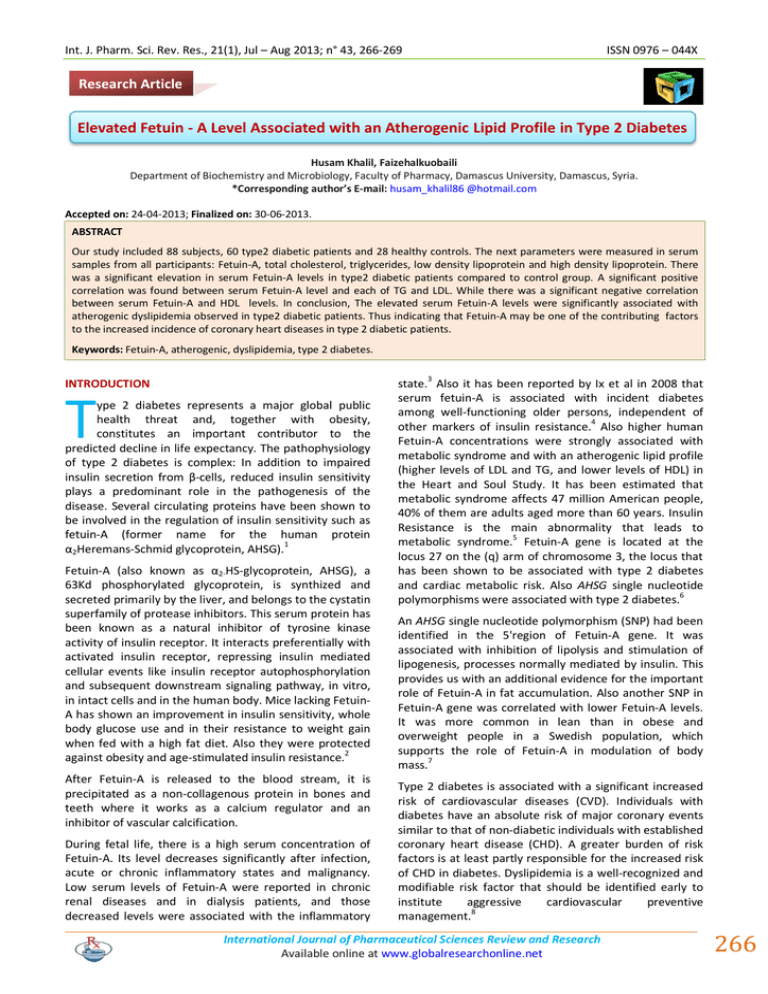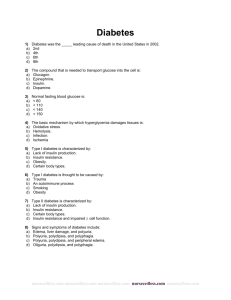Document 13309179
advertisement

Int. J. Pharm. Sci. Rev. Res., 21(1), Jul – Aug 2013; n° 43, 266-269 ISSN 0976 – 044X Research Article Elevated Fetuin - A Level Associated with an Atherogenic Lipid Profile in Type 2 Diabetes Husam Khalil, Faizehalkuobaili Department of Biochemistry and Microbiology, Faculty of Pharmacy, Damascus University, Damascus, Syria. *Corresponding author’s E-mail: husam_khalil86 @hotmail.com Accepted on: 24-04-2013; Finalized on: 30-06-2013. ABSTRACT Our study included 88 subjects, 60 type2 diabetic patients and 28 healthy controls. The next parameters were measured in serum samples from all participants: Fetuin-A, total cholesterol, triglycerides, low density lipoprotein and high density lipoprotein. There was a significant elevation in serum Fetuin-A levels in type2 diabetic patients compared to control group. A significant positive correlation was found between serum Fetuin-A level and each of TG and LDL. While there was a significant negative correlation between serum Fetuin-A and HDL levels. In conclusion, The elevated serum Fetuin-A levels were significantly associated with atherogenic dyslipidemia observed in type2 diabetic patients. Thus indicating that Fetuin-A may be one of the contributing factors to the increased incidence of coronary heart diseases in type 2 diabetic patients. Keywords: Fetuin-A, atherogenic, dyslipidemia, type 2 diabetes. INTRODUCTION T ype 2 diabetes represents a major global public health threat and, together with obesity, constitutes an important contributor to the predicted decline in life expectancy. The pathophysiology of type 2 diabetes is complex: In addition to impaired insulin secretion from β-cells, reduced insulin sensitivity plays a predominant role in the pathogenesis of the disease. Several circulating proteins have been shown to be involved in the regulation of insulin sensitivity such as fetuin-A (former name for the human protein α2Heremans-Schmid glycoprotein, AHSG).1 Fetuin-A (also known as α2-HS-glycoprotein, AHSG), a 63Kd phosphorylated glycoprotein, is synthized and secreted primarily by the liver, and belongs to the cystatin superfamily of protease inhibitors. This serum protein has been known as a natural inhibitor of tyrosine kinase activity of insulin receptor. It interacts preferentially with activated insulin receptor, repressing insulin mediated cellular events like insulin receptor autophosphorylation and subsequent downstream signaling pathway, in vitro, in intact cells and in the human body. Mice lacking FetuinA has shown an improvement in insulin sensitivity, whole body glucose use and in their resistance to weight gain when fed with a high fat diet. Also they were protected 2 against obesity and age-stimulated insulin resistance. After Fetuin-A is released to the blood stream, it is precipitated as a non-collagenous protein in bones and teeth where it works as a calcium regulator and an inhibitor of vascular calcification. During fetal life, there is a high serum concentration of Fetuin-A. Its level decreases significantly after infection, acute or chronic inflammatory states and malignancy. Low serum levels of Fetuin-A were reported in chronic renal diseases and in dialysis patients, and those decreased levels were associated with the inflammatory state.3 Also it has been reported by Ix et al in 2008 that serum fetuin-A is associated with incident diabetes among well-functioning older persons, independent of other markers of insulin resistance.4 Also higher human Fetuin-A concentrations were strongly associated with metabolic syndrome and with an atherogenic lipid profile (higher levels of LDL and TG, and lower levels of HDL) in the Heart and Soul Study. It has been estimated that metabolic syndrome affects 47 million American people, 40% of them are adults aged more than 60 years. Insulin Resistance is the main abnormality that leads to metabolic syndrome.5 Fetuin-A gene is located at the locus 27 on the (q) arm of chromosome 3, the locus that has been shown to be associated with type 2 diabetes and cardiac metabolic risk. Also AHSG single nucleotide polymorphisms were associated with type 2 diabetes.6 An AHSG single nucleotide polymorphism (SNP) had been identified in the 5'region of Fetuin-A gene. It was associated with inhibition of lipolysis and stimulation of lipogenesis, processes normally mediated by insulin. This provides us with an additional evidence for the important role of Fetuin-A in fat accumulation. Also another SNP in Fetuin-A gene was correlated with lower Fetuin-A levels. It was more common in lean than in obese and overweight people in a Swedish population, which supports the role of Fetuin-A in modulation of body mass.7 Type 2 diabetes is associated with a significant increased risk of cardiovascular diseases (CVD). Individuals with diabetes have an absolute risk of major coronary events similar to that of non-diabetic individuals with established coronary heart disease (CHD). A greater burden of risk factors is at least partly responsible for the increased risk of CHD in diabetes. Dyslipidemia is a well-recognized and modifiable risk factor that should be identified early to institute aggressive cardiovascular preventive 8 management. International Journal of Pharmaceutical Sciences Review and Research Available online at www.globalresearchonline.net 266 Int. J. Pharm. Sci. Rev. Res., 21(1), Jul – Aug 2013; n° 43, 266-269 The lipoprotein abnormalities commonly present in type 2 diabetes, previously termed noninsulin-dependent diabetes mellitus, include hypertriglyceridemia and reduced plasma HDL cholesterol. In addition, low density lipoprotein (LDL) are converted to smaller, perhaps more atherogenic, lipoproteins termed small dense LDL. In contrast to type 1 diabetes, this phenotype is not usually fully corrected with glycemic control. Moreover, this dyslipidemia often is found in prediabetics, patients with insulin resistance but normal indexes of plasma glucose. Therefore, abnormalities in insulin action and not hyperglycemia itself are associated with this lipid 9 abnormality. MATERIALS AND METHODS Study Groups Our study included 88 subjects, aged between 25-66 years, and divided into 2 groups: Control group: This group included 28 well-being individuals (7 males, 21 females) who neither had diabetes nor took any medicines. Mean age was 40.2±10.7 years, and mean body mass index ± standard deviation (SD) was 30.3 ± 5.14 Kg\m2. ISSN 0976 – 044X The serum which was obtained was stored at -80ºC until assay date (for up to 4 months). Assay methods Fetuin-A was assayed using Human Fetuin-A Elisa kit (Sandwich type) from DIA source ImmunoAssays SA-Rue du Bosquet 2, B-Louvain-la-Neuve, Belgium. Total cholesterol (Chol), Triglycerides (TG), Low Density Lipoprotein (LDL) and High Density Lipoprotein (HDL) were assayed using Hitachi 912 analyzer and kits from Roche, Switzerland. RESULTS AND DISCUSSION Table 1 shows means ± SD of serum levels of fetuin-A, Total cholesterol (Chol), Triglycerides (TG), Low Density Lipoprotein (LDL) and High Density Lipoprotein (HDL) in controls and diabetic patients. Significant increase in serum Fetuin-A, Total chol, TG, LDL (P<0.001) was found in the diabetic group as compared to controls. HDL was significantly decreased in the same patient group (p<0.001). Table 1: Serum Fetuin-A, Total Chol, TG, LDL and HDL in controls and diabetic patients (Mean±SD) Control group (n=28) Fetuin-A(mg\L) Diabetic group(n=60) 2.76±1.38 4.11±1.58* Type 2 Diabetic patients group: It included 60 type 2 diabetic patients (27 males, 33 females) who were taking at least one of the oral hypoglycemic agents. Their mean age was 50.4± 9.7 years. Mean body mass index ± standard deviation was 31.02 ± 5.97 Kg\m2. Total Chol(mg\dl) 174.39±33.35 207.01±40.78* TG(mg\dl) 119.2±72.28 192.9±110.38* LDL(mg\dl) 95.1±24.78 128.28±38.65* HDL(mg\dl) 51.21±13.19 39.86±12.75* Exclusion Criteria *P<0.001. Individuals who had a history of liver diseases, renal diseases, cardiovascular diseases, chronic infections or malignancies were excluded from our study. A significant positive correlation was found between serum fetuin-A level and each of: Sampling TG (r=0.295, P<0.02) figure 2. Samples were obtained between 18/7/2012 as following: 22/4/2012 and Patient samples were taken from patients attended endocrinology clinics in Al-Asad University Hospital and the specialized medical centers. Total Chol (r=0.417, P<0.01) figure 1. LDL (r=0.388, P<0.01) figure 3. A significant negative correlation was found between serum Fetuin-A and HDL (r=-0.35, P<0.01) figure 4. Control samples were taken from healthy volunteers attended Damascus University center for blood transfusion. The aim of the study was explained to the subjects and those who gave their consent were included in the study, then they underwent a medical history interview and a comprehensive health status questionnaire. In both the patients and the controls, about 5 ml of fasting blood was obtained by venipuncture by using sterile disposable syringes and needles. The blood was collected into centrifuge tubes. It was allowed to clot and it was then centrifuged at 3000 rpm for 15 min at room temperature. Figure 1: Correlation between serum Fetuin-A levels and Total Cholesterol. International Journal of Pharmaceutical Sciences Review and Research Available online at www.globalresearchonline.net 267 Int. J. Pharm. Sci. Rev. Res., 21(1), Jul – Aug 2013; n° 43, 266-269 ISSN 0976 – 044X 10 11 Ou et al (2011). While Mori et al (2006) found no significant differences in serum Fetuin-A levels between the type 2 diabetic group and the control group. Figure 2: Correlation between serum Fetuin-A and Triglyceride levels. Also, in our study there was a significant elevation in the serum concentrations of: Total cholesterol (Total chol), Triglycerides (TG) and low density lipoprotein (LDL) in type 2 diabetic patients compared to controls. While HDL levels were significantly decreased in type 2 diabetic patients as compared to controls. Our results came 12 consistent with the results of Samatha et al (2012). They found higher frequencies of elevated levels of total cholesterol, triglycerides and low density lipoprotein in type 2 diabetic patients as compared to controls. Also, Smith et al (2008) concluded that hypercholesterolemia, hypertriglyceridemia and elevated low density lipoprotein are the main lipid abnormalities found in diabetes which is risk for coronary artery disease.13 This specific pattern of dyslipidemia that commonly accompanies diabetes type 2 could be explained by the presence of insulin resistance in target tissues which leads to disturbances in the hormone functions of insulin, especially in liver apoprotein production, regulation of lipoprotein lipase (LpL) activity and regulation of Cholesteryl ester transfer protein (CETP) actions and peripheral actions of insulin on adipose tissues and muscles. Our study showed a significant correlation between elevated serum Fetuin-A levels and an atherogenic lipid profile in type 2 diabetic patients. A significant positive correlation was found between serum Fetuin-A level and each of Total Chol, TG and LDL. Figure 3: Correlation between serum Fetuin-A and LDL. Figure 4: Correlation between serum Fetuin-A and HDL. We aimed to study the serum levels of Fetuin-A in type 2 diabetic patients and its possible role in the development of an atherogenic lipid profile in these patients (known as Diabetic Dyslipidemia) to see if Fetuin-A could be considered as a possible risk factor for coronary heart diseases in type 2 diabetes. In our study, significantly elevated serum Fetuin-A levels were shown in type 2 diabetic patients as compared to controls. Our results came consistent with the results of While there was a significant negative correlation between serum Fetuin-A and HDL levels. Our results came consistent with the results of Ishibashi et al (2010).14 They concluded that elevated serum Fetuin-A is an independent marker for an atherogenic lipid profile.There was an agreement between our results and the results of Ix et al (2006).5 Their results showed a strong association between higher Fetuin-A concentrations and each of metabolic syndrome and an atherogenic lipid profile (higher levels of LDL and TG, and lower levels of HDL). This could be explained that Fetuin-A leads to these changes in lipid profile either directly or indirectly through its effects on insulin receptor tyrosine kinase activity. Since inhibition of lipolysis in adipose tissues is one of the most serious effects of insulin, the inhibition of insulin receptor by means of Fetuin-A could lead to increased lipolysis and excessive release of free fatty acids from adipose tissues, which are reassembled into triglycerides in the liver and this leads to an increased production of B-Apolipoprotein containing very low density lipoprotein (VLDL), which is partly converted to LDL Also, the resultant hypertriglyceridemia could lead to a decrease in the cholesterol content of HDL molecules which could enhance their clearance from blood circulation, and at 9 the end an atherogenic lipid profile appears. International Journal of Pharmaceutical Sciences Review and Research Available online at www.globalresearchonline.net 268 Int. J. Pharm. Sci. Rev. Res., 21(1), Jul – Aug 2013; n° 43, 266-269 CONCLUSION The elevated serum Fetuin-A levels found in type 2 diabetic patients were significantly associated with atherogenic dyslipidemia observed in those patients. Thus indicating that Fetuin-A may be one of the contributing factors to the increased incidence of coronary heart diseases in type 2 diabetic patients. REFERENCES ISSN 0976 – 044X 7. Lavebratt C, Wahlqvist S, Nordfors L, Hoffstedt J, Arner P. AHSG gene variant is associated with leanness among Swedish men. HUMAN GENETICS, 117, 2005, 54-60. 8. Solano MP, Goldberg RB. Lipid Management in Type 2 Diabetes. CLINICAL DIABETES, 24, 2006, 27-32. 9. Goldberg IJ. Diabetic Dyslipidemia, Causes and Consequences. JOURNAL OF CLINICAL ENDOCRINOLOGY AND METABOLISM, 86, 2001, 965-971. 1. Stefan N, Fritsche A, Weikert C, Boeing H, Joost HG, Häring HU, Plasma Fetuin-A Levels and the Risk of Type 2 Diabetes. DIABETES, 57, 2008, 2762–2767. 10. Ou HY, Yang YC, Wu HT, Wu JS, Lu FH, Chang CJ. Serum fetuin-A concentrations are elevated in subjects with impaired glucose tolerance and newly diagnosed type 2 diabetes. CLIN ENDOCRINOL, 2011, 75, 450-5. 2. Hennige AM, Staiger H, Wicke C, Machicao F, Fritsche A, Häring HU, Fetuin-A Induces Cytokine Expression and Suppresses Adiponectin Production. PLoS One, 3, 2008, 1765. 11. Mori K, Emoto M, Yokoyama H, Araki T, Teramura M, Koyama H, Association of Serum Fetuin-A With Insulin Resistance in Type 2 Diabetic and Nondiabetic Subjects. DIABETES CARE, 29, 2006, 468. 3. Häusler M, Schäfer C, Osterwinter C, Jahnen-Dechent W. The physiologic development of fetuin-a serum concentrations in children. PEDIATRIC RESEARCH, 66, 2009, 660-664. 12. Samatha P, Venkateswarlu M, Siva Prabodh V. Lipid Profile Levels in Type 2 Diabetes Mellitus from the Tribal Population of Adilabad in Andhra Pradesh, India. JOURNAL OF CLINICAL AND DIAGNOSTIC RESEARCH, 6, 2012, 590-592. 4. Ix JH, Wassel CL, Kanaya AM, Vittinghoff E, Johnson KC, Koster A, Fetuin-A and Incident Diabetes Mellitus in Older Persons. JOURNAL OF THE AMERICAN MEDICAL ASSOCIATION, 300, 2009, 182-188. 5. Ix JH, Shlipak MG, Brandenburg VM, Ali S, Ketteler M,Whooley MA. Association between human fetuin-A and the metabolic syndrome, data from the Heart and Soul Study. Circulation, 113, 2006, 1760-1767. 13. Smith S, Lall AM. A Study on Lipid Profile Levels of Diabetics and Non-Diabetics Among Naini Region of Allahabad, India. TURKISH JOURNAL OF BIOCHEMISTRY, 33, 2008, 138–141. 14. Ishibashi A, Ikeda Y, Ohguro T, Kumon Y, Yamanaka S, Takata H, Serum Fetuin-A is an Independent Marker of Insulin Resistence in Japanese Men. JOURNAL OF ATHEROSCLEROSIS AND THROMBOSIS, 17, 2010, 925-933. 6. Stefan N, Fritsche A, Weikert C, Boeing H, Joost HG, Häring HU, Plasma Fetuin-A Levels and the Risk of Type 2 Diabetes. DIABETES, 57, 2008, 2762–2767. Source of Support: Nil, Conflict of Interest: None. International Journal of Pharmaceutical Sciences Review and Research Available online at www.globalresearchonline.net 269




